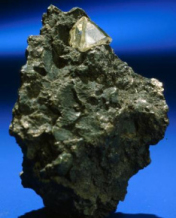Diamonds could have been used to adorn a newly created Lucifer (Ezekiel 28:13). Though quite rare, they are not mentioned in the Bible as one of the many precious minerals God will use to create the twelve foundations needed for the New Jerusalem (see Revelation 21:19 - 21).
God, speaking through the prophet Jeremiah, uses diamond's well known hardness as an analogy to show how entrenched were the sins committed by the Kingdom of Judah. He states that, "The sin of Judah is engraved with a pen of iron, with the point of a diamond (Hebrew shamiyr, Strong's Concordance #H8068); it is carved upon the tablet of their heart and upon the horns of your altars . . ." (Jeremiah 17:1).
The Hebrew word, from which we get the English word for this precious stone in the Bible, denotes something that can prick (like a thorn or thorn bush) or something that is sharp (Strong's and BDB lexicon).
Diamonds are the hardest mineral known to man, possessing a Mohs hardness scale rating of ten. Engagement rings made of this rare gemstone have been popular from at least the 15th century.

According to a 2013 USGS minerals yearbook report, world natural production of diamonds stood at 130 million carats. The biggest producers of such stones (in decreasing order) were Russia, Botswana, Congo, Australia and Canada, which together generated 76% of the world's supply.
Gemstone Folklore
Because of this gemstone's many desirable characteristics (clarity, purity, hardness, rarity, etc.) it had many powers and abilities attributed to it.
This gemstone was considered an emblem of invincibility and fearlessness. It gave the wearer courage, extra strength and the stamina to be victorious. It could drive away nighttime evil spirits and ghosts, bring good luck to a person, and even make someone invisible! This gem was also believed to have reproductive powers. Diamonds were associated with lightning and believed to be products of electrical strikes.
Like the turquoise, this rare gem was thought to lose its talisman-like powers if they were bought. Only stones received as a gift, it was believed, would retain their supernatural abilities (Curious Lore of Precious Stones, pages 69 - 73).
Fun Facts
Where is the only place in the entire world where you can hunt for this rare and incredibly valuable gemstone for a small fee and keep what you find?
The Crater of Diamonds State Park in the U.S. state of Arkansas is the world's eighth largest diamond bearing volcanic crater. The park offers the public a chance to search for this valuable precious stone. From 1972, (the year the area became a state park) to 2013, 30,891 rough versions of this precious stone have been discovered with a total weight of about 6,173 carats (USGS 2013 Minerals Yearbook for Gemstones).